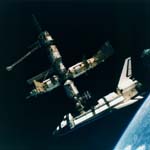|
|||||
 |
 |
| Mission Overview | Flight Plan | Crew |
|
|
 STS-91
is a National Aeronautics and Space Administration (NASA) Space Shuttle mission.
A series of precursor missions aimed to mitigate the risks of the construction
and the operation of the International Space Station is being conducted by docking
the Space Shuttle with the Russian space station Mir on orbit. NASDA is taking
this opportunity to conduct Space Radiation Environment Monitoring experiments
to develop radiation monitoring technology and to acquire data related to radiation
effect management. This experiment is the final one a series of four experiments
which have been conducted since September 1996 aboard STS-79,
84
and 89.
STS-91
is a National Aeronautics and Space Administration (NASA) Space Shuttle mission.
A series of precursor missions aimed to mitigate the risks of the construction
and the operation of the International Space Station is being conducted by docking
the Space Shuttle with the Russian space station Mir on orbit. NASDA is taking
this opportunity to conduct Space Radiation Environment Monitoring experiments
to develop radiation monitoring technology and to acquire data related to radiation
effect management. This experiment is the final one a series of four experiments
which have been conducted since September 1996 aboard STS-79,
84
and 89.
During this STS-91 mission, many other experiments will be performed using
equipment in the Spacehab and Get Away Special (GAS) containers both located
in the cargo bay, and other equipment in the mid-deck of the Space Shuttle.
Another feature of STS-91 is that a newly designed Super Lightweight External
Tank (SLET) will be used for the first time on this mission. The SLET is
more than 7000 pounds lighter than the conventional External Tank, thus
expanding the payload capacity of the Space Shuttle.
Launch Schedule
| Shuttle Mission | STS-91 | |
| Orbiter | Discovery (24th flight) | |
| Launch (Estimated) | June 2, 1998 6:10 p.m. EDT | |
| Launch Site | NASA Kennedy Space Center Pad 39A | |
| Duration (Estimated) | 9 days, 19 hours, 53 minutes | |
| Crew | 7 ( Descent Only:1) | |
| Altitude | 173 nautical miles | |
| Inclination | 51.6 degrees | |
| Landing Date (Estimated) | June 12, 1998 2:03 p.m. EDT | |
| Landing Site (Estimated) | NASA Kennedy Space Center | |
| Purpose of NASDA experiments on STS-91 mission |
On the STS-91 mission, the real time Radiation Monitoring Device (RRMD)
will fly onboard the Shuttle as part of the equipment for the Radiation
Measurement. RRMD will be used to cover whole range of Linear Energy Transfer
(LET) . As in the previous three missions, the data from the RRMD will
be transferred to Japan in real time and will be used for research for
the preliminary space radiation forecasting.
A practical measurement will be performed using a human body model (Human
Body Phantom) made of material equivalent to the human tissue or organs
in terms of radiation. Dosimeters will be installed in many locations inside
the model where a distribution of radiation dose will be analyzed. By comparing
data inside the Phantom and RRMD data (outside the human body) measured,
researchers will be able to accurately estimate the dose distribution of
space radiation inside the human body.
In addition to the physical measurement above, biological experiments to
investigate the effects of microgravity on radiation damage of DNA will
be performed.
Last Updated : June 2, 1998
| Mission Overview | Flight Plan | Crew |

|